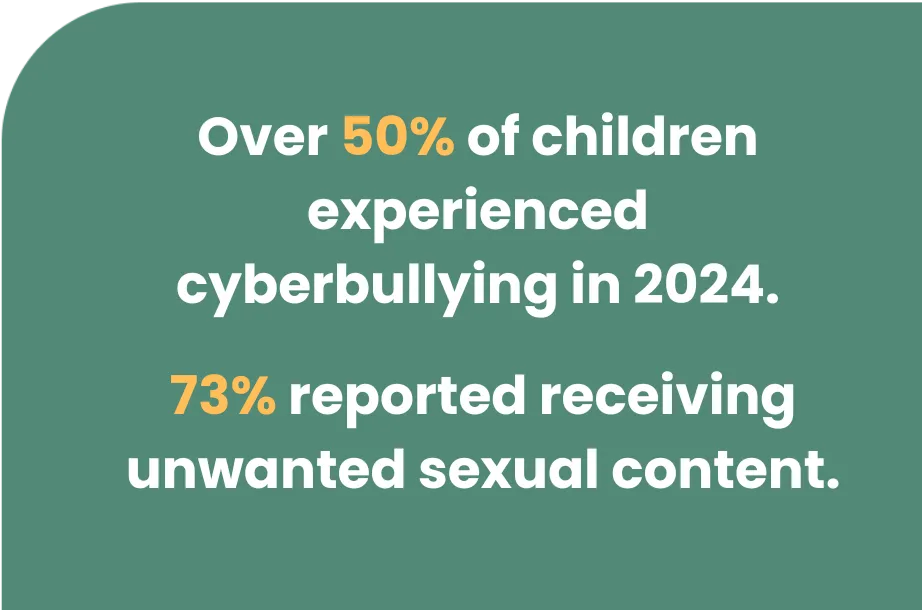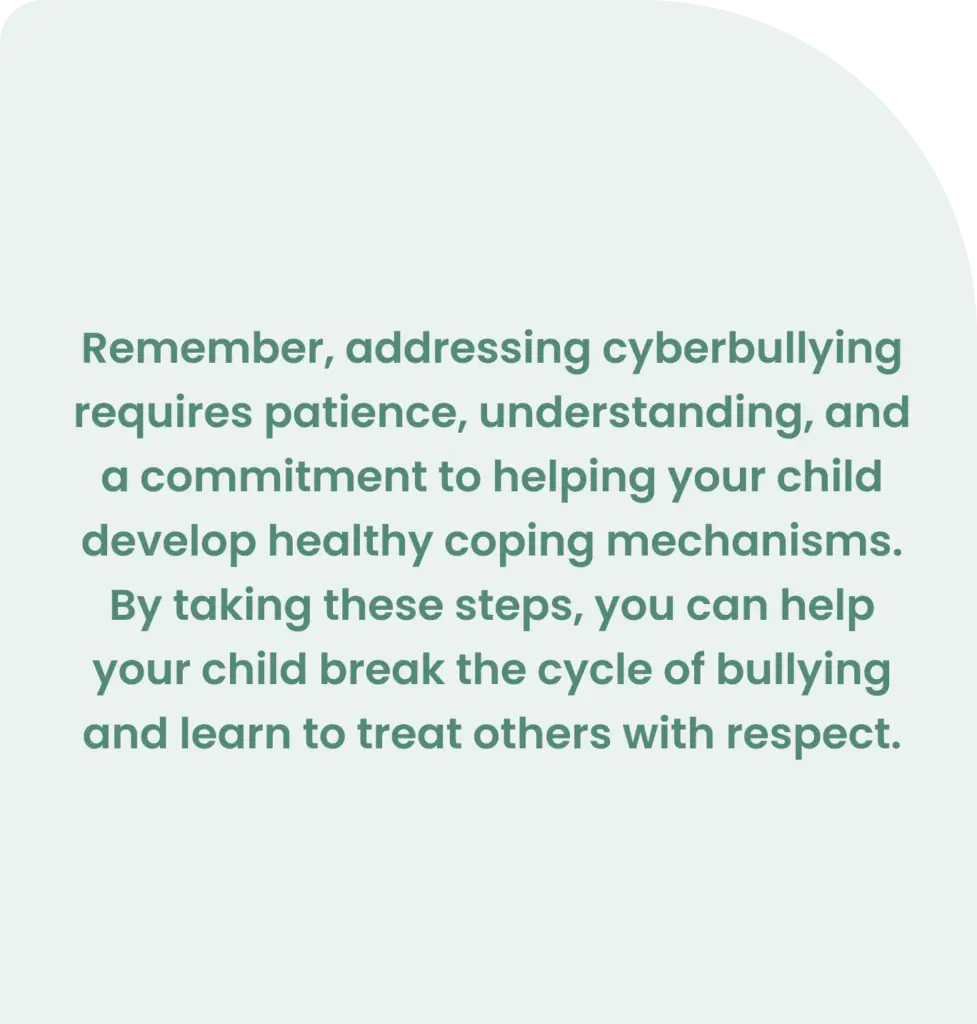How to Deal With Cyberbullying: A Comprehensive Guide for Parents

The Growing Threat of Cyberbullying
Cyberbullying has become a pervasive issue in today’s digital age, with its prevalence and severity increasing over the years. Unlike traditional bullying, cyberbullying occurs online, allowing perpetrators to hide behind screens and inflict harm anonymously, causing significant damage to children and adolescents. As parents, it’s crucial to understand the tactics used by cyberbullies and take proactive steps to protect your child.
This guide aims to demystify cyberbullying for you, providing insight and support every step of the way, empowering you to protect and guide your child through this difficult experience.

The Shocking Statistics
Cyberbullying has reached alarming proportions, with over 50% of children experiencing it in 2024. Girls and young women are particularly vulnerable, with 73% reporting receiving unwanted sexual content last year alone. Even gamers are not immune, with 6 in 10 experiencing severe harassment, half reporting discrimination, and over a quarter reporting sexual harassment.
A study conducted between 2007 and 2023 found that almost 31% of US students have been bullied online at some point in their lives, highlighting the widespread nature of this issue.
The insidious nature of cyberbullying leaves lasting scars on both victims and perpetrators.

According to the Cyberbullying Research Center, in 2023, the most common forms of cyberbullying experienced (among those who were cyberbullied) included:

Someone posted mean or hurtful comments about me online.

Someone spread rumors about me online.

Someone embarra-ssed or humiliate me online.

Someone inten-tionally excluded me from a group text or group chat.

Someone repeatedly contacted me via text or online after I told them to stop.
Understanding Cyberbullying
Cyberbullying involves the use of technology to harass, threaten, or embarrass someone. It can occur on various platforms, including social media, messaging apps, gaming platforms, and email. Cyberbullying can have a devastating impact on victims, leading to low self-esteem, depression, anxiety, and even suicidal thoughts.


Common Cyberbullying Tactics

Flaming:
Sending hostile or insulting messages online, often using vulgar or abusive language.

Denigration:
Posting negative or false information about someone online, often targeting their appearance, character, or abilities.

Impersonation:
Creating a fake online profile to pretend to be someone else and spread rumors or misinformation

Outing:
Sharing someone's personal information online without their consent, often with malicious intent.

Exclusion:
Intentionally excluding someone from online groups or activities, often as a form of punishment or social isolation.

Masquerading:
Pretending to be someone else to trick or deceive a victim.

Stalking:
Repeatedly harassing or threatening someone online, even after they have asked to be left alone.

Tricking:
Using deception or manipulation to trick someone into revealing personal information or engaging in harmful activities

Cyberbullying through apps:
Using messaging apps or other platforms to send harmful or threatening messages.

Revenge porn:
Sharing sexually explicit images or videos of someone without their consent
Common Cyberbullying Tactics
Headaches, stomachaches, sleep disturbances, changes in eating habits.


The Devastating Impact of Cyberbullying
- Low self-esteem: Victims may feel ashamed, embarrassed, or worthless.
- Depression and anxiety: Cyberbullying can contribute to depression, anxiety, and even suicidal thoughts.
- Academic difficulties: Victims may struggle to focus on schoolwork and experience academic decline.
- Social isolation: Cyberbullying can lead to social withdrawal and isolation.
- Physical health problems: Cyberbullying can contribute to physical health issues, such as headaches, stomachaches, and sleep problems.



Psychological:
Social:
Moral:
Protecting Your Child from Cyberbullying
- Talk to your child: Encourage open communication and create a safe space for your child to share their experiences.
- Document the incidents: Save any evidence of cyberbullying, such as screenshots, emails, or text messages.
- Report the bullying: Contact the platform where the bullying is occurring and report the incident.
- Seek support: Reach out to other parents, school counselors, or mental health professionals for support and guidance.
- Empower your child: Teach your child how to respond to cyberbullying in a healthy and constructive way.


Age-Specific Signs:
The Role of Parents and Educators

Cyberbullying knows no boundaries. It follows your child wherever they venture online.

Understanding the Psychology of Cyberbullies
- Power and control: Cyberbullies may seek to gain power and control over their victims, often driven by feelings of inadequacy or insecurity.
- Revenge: Cyberbullies may target victims as a form of revenge for perceived slights or conflicts.
- Boredom or entertainment: Some cyberbullies may engage in bullying for amusement or to relieve boredom.
- Lack of empathy: Cyberbullies may lack empathy and understanding for the consequences of their actions.
- Peer pressure: In some cases, cyberbullies may be influenced by their peers or a desire to fit in.
Recognizing the Signs of Cyberbullying in Your Child
- Changes in behavior: Withdrawal from social activities, decreased interest in hobbies, or changes in mood.
- Avoidance of technology: Reluctance to use electronic devices or spend time online.
- Physical symptoms: Headaches, stomachaches, or sleep problems.
- Academic difficulties: Struggling to focus on schoolwork or experiencing a decline in grades.
- Social isolation: Becoming withdrawn from friends and family.
- Changes in appearance: Changes in eating habits, sleep patterns, or physical appearance.
- Difficulty concentrating: Struggling to focus or pay attention.
- Sudden outbursts of anger or aggression.

When Your Child is the Bully

Acknowledge the Problem:
The first step is to acknowledge that your child may be involved in cyberbullying. It can be difficult to admit, but denial won't help resolve the situation.Discover the benefits of the Troomi Parent Portal here.

Open Communication:
Establish open communication with your child. Create a safe space for them to talk about their feelings and experiences. Avoid blaming or shaming them, as this may make them less likely to open up.

Understand the Motivations:
Try to understand why your child might be engaging in cyberbullying. Are they seeking attention, trying to fit in, or experiencing personal difficulties?

Set Clear Boundaries:
Establish clear rules and consequences for cyberbullying. Explain the harmful effects of their behavior and the importance of treating others with respect.

Seek Professional Help:
If your child is struggling with anger, aggression, or other underlying issues, consider seeking professional help from a therapist or counselor.



Encourage Empathy and Understanding:
Help your child develop empathy and understanding for others. Encourage them to put themselves in the shoes of their victims and consider the consequences of their actions.

Monitor Online Activity:
Keep an eye on your child's online activity to identify any warning signs of cyberbullying. This includes checking their social media accounts, emails, and messaging apps.

Educate Your Child About Cyberbullying:
Teach your child about the harmful effects of cyberbullying and the importance of treating others with respect. Explain the legal consequences of cyberbullying and the potential long-term impact on their own reputation and future.

Provide Positive Role Modeling:
Demonstrate respectful online behavior yourself and avoid engaging in any form of bullying or harassment.

Seek Support:
Connect with other parents or support groups for advice and guidance. There are many resources available to help parents deal with cyberbullying.
Creating a Safe Online Environment
- Setting clear rules and expectations: Establish clear rules and expectations for your child’s online behavior, including time limits and appropriate content.
- Using parental controls: Utilize parental control features on devices and platforms to monitor and restrict your child’s online activity.
- Educating your child about online safety: Teach your child about the dangers of sharing personal information, the importance of strong passwords, and the risks of talking to strangers online.
- Encouraging healthy online habits: Promote positive online experiences by encouraging your child to engage in activities that foster creativity, learning, and social connections.
- Monitoring online activity: Regularly check your child’s social media accounts, gaming platforms, and chat histories.
- Talking to your child about cyberbullying: Have open conversations with your child about the dangers of cyberbullying and encourage them to report any suspicious activity.

Specific Coping Mechanisms
Mindfulness exercises
Social support building
Encourage communication with close friends, family members, or a therapist to build a network of support and understanding.
Creative expression
Journaling, drawing, music, or other activities to process and express emotions constructively.
Physical activity

Seeking Help
- The Cyberbullying Research Center: https://cyberbullying.org/
- The National Center for Missing & Exploited Children: https://report.cybertip.org/
- The National Suicide Prevention Lifeline: 1-800-273-8255
Here are some valuable resources to help parents address cyberbullying:
National Organizations
- The Cyberbullying Research Center: https://cyberbullying.org/
- The National Center for Missing & Exploited Children: https://report.cybertip.org/
- StopBullying.gov: https://www.stopbullying.gov/
- The Trevor Project: https://www.thetrevorproject.org/
Online Support Groups and Communities:
- The Jed Foundation: https://jedfoundation.org/
- The National Alliance on Mental Illness (NAMI): https://www.nami.org/
- ParentConnect: https://www.cusd.com/ParentConnection.aspx
Apps and Tools:
- Troomi: https://troomi.com/how-troomi-works/
- Qustodio: https://www.qustodio.com/en/
- Screen Time: https://support.apple.com/en-us/108806
Government Agencies:
- Federal Trade Commission (FTC): https://www.ftc.gov/
- Federal Communications Commission (FCC): https://www.fcc.gov/


